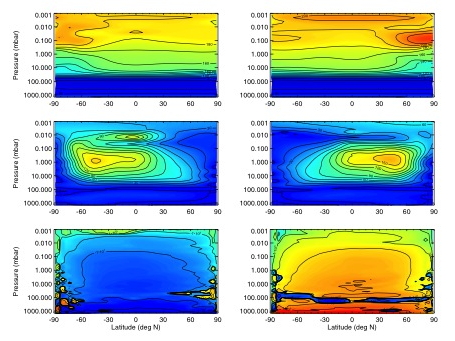2012 Annual Science Report
 NASA Jet Propulsion Laboratory - Titan
Reporting | SEP 2011 – AUG 2012
NASA Jet Propulsion Laboratory - Titan
Reporting | SEP 2011 – AUG 2012
Task 2.1.2.1 Atmospheric State and Dynamics
Project Summary
To support the master atmospheric model, realistic Titan atmospheric profiles [winds, temperatures and densities] from the surface to ~1200km, for a variety of seasons and solar cycles, is needed.
Project Progress
Co-Investigators Claire Newman and Mark Richardson are working to produce realistic Titan atmospheric profiles [winds, temperatures and densities] from the surface to ~1200km, for a variety of seasons and solar cycles, for use by the Titan atmospheric chemistry model.
The approach chosen is to combine results from a lower/middle atmosphere Titan general circulation model (GCM) [TitanWRF], extending from the surface to ~430km, with results from an upper atmosphere model [such as the TGCM, run by Ingo Müller-Wodarg at ICL], which extends from ~600 to >1200km. However, simply taking results from these models and interpolating over the gap region would be highly undesirable, as (a) the ‘gap’ region is expected to have complex variations, and in addition (b) the upper atmosphere is greatly impacted by the lower atmospheric flow.
Addressing (a) requires downward/upward extension of the TGCM/TitanWRF model lower/upper boundary. The upper boundary of the TitanWRF model is thus being extended to 500km (midway through the ‘gap’ region) prior to adding advected haze particles into simulations. Raising the upper boundary should improve the match to CIRS observations as this will then avoid ‘cutting off’ the top of the overturning circulation, and is also necessary to capture more of the haze production region for advected haze simulations (which should also improve the realism of results by introducing feedbacks between circulation and the distribution of absorbers).
To address (b), a ‘pseudo-coupling’ of the lower and upper atmosphere models will be attempted, using winds, densities and temperatures output from the upper layers of TitanWRF to force the lower boundary of the TGCM. The past year has seen a continuation of the collaboration with Ingo Müller-Wodarg, but also a new collaboration with a second Titan thermosphere modeling effort using the TGCM of Jared Bell (formerly at SWRI and now at the National Institute of Aerospace).
A year-long, 8-hourly-output TitanWRF dataset from 0 to 400km has been produced and used in generating streamfunctions needed for the photochemistry model.
In addition to the TitanWRF GCM, a second GCM – the Titan MITgcm – has been developed at Ashima Research. Zonal mean temperatures, winds and streamfunctions for both solstices are shown in Figure 1. This was done in part to validate TitanWRF results and confirm the robustness of the mechanisms for superrotation (and hence circulation) identified in the original model. The Titan MITgcm does not yet attain the observed wind magnitudes in the stratosphere – work is ongoing to identify the reason for this – but still performs better than any other existing Titan GCM with the exception of TitanWRF.

Figure 1: Titan MITgcm results showing zonal-mean temperatures (in K, top row), zonal winds (in m/s, middle row) and mass streamfunctions (in kg/s, bottom row) averaged over 12 Titan days around northern summer (Ls~90°, left column) and winter (Ls~270°, right column) solstice. Positive streamfunction values indicate clockwise rotation.
-
PROJECT INVESTIGATORS:
-
PROJECT MEMBERS:
Mark Richardson
Co-Investigator
-
RELATED OBJECTIVES:
Objective 2.2
Outer Solar System exploration
Objective 3.1
Sources of prebiotic materials and catalysts
